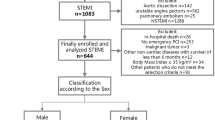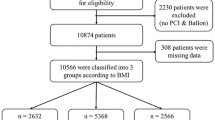Abstract
Obesity is a traditional risk factor for the development of cardiovascular disease. However, recent studies have described a better outcome of obese patients in the clinical course of acute coronary syndromes.
We investigated the impact of the body mass index (BMI) on occurrence and outcome of acute ST-elevation myocardial infarction (STEMI). Data of 10 534 consecutive patients with STEMI of the German MITRA PLUS registry were analyzed, comparing international classes of the BMI (obesity: BMI ≥ 30 kg/m2, overweight: 25–29.9 kg/m2, normal weight: 18.5–24.9 kg/m2).
STEMI occurred at a younger age in obese patients. The obese patients with first STEMI were 3 years younger than the normal weight patients with first STEMI (62.5 vs 65.7 years, p <0.0001).
After STEMI has occurred, the obese patients had the lowest hospital (6.0%) and long-term mortality (4.8%) of all compared BMI-groups. In a multivariate analysis, obesity compared to normal weight was associated with a trend of a reduced mortality without significance during the hospital course (OR 0.81, 95% CI 0.60–1.08) and with significance during follow-up (OR 0.56, 95% CI 0.40–0.79).
In conclusion, our data show that obesity is a risk factor of a manifestation of STEMI at a younger age compared to normal weight patients. After STEMI has occurred, obesity is associated with a trend of a lower mortality during the following clinical course. Therefore, the focus of prevention should be the reduction of obesity and metabolic syndrome in young people, to avoid the early occurrence of STEMI by primary prevention.
Similar content being viewed by others
References
Hubert HB, Feinleib M, McNamara PM, Castelli WP (1983) Obesity is an independent risk factor for cardiovascular disease: a 26-year follow-up of participants in the Framingham Heart Study. Circulation 67:968–977
Ellis SG, Elliot J, Horrigan M, Raymond RE, Howell G (1996) Low-normal or excessive body mass index: newly identified risk factors for death and other complications with percutaneous coronary intervention. Am J Cardiol 78:642–664
Gurm HS, Whitlow PL, Kip KE; BARI Investigators (2002) The impact of body mass index on short- and longterm outcomes in patients undergoing coronary revascularization. Insights from the bypass angioplasty revascularization investigation (BARI). J Am Coll Cardiol 39(5):834–840
Gruberg L, Weissman NJ, Waksman R, Fuchs S, Deible R, Pinnow EE, Ahmed LM, Kent KM, Pichard AD, Suddath WO, Satler LF, Lindsay J (2002) The impact of obesity on the short-term and long-term outcomes after percutaneous coronary intervention: the obesity paradox? J Am Coll Cardiol 39(4):578–584
Minutello RM, Chou ET, Hong MK, Bergman G, Parikh M, Iacovone F, Wong SC (2004) Impact of body mass index on in-hospital outcomes following percutaneous coronary intervention (report from the New York State Angioplasty Registry). Am J Cardiol 93(10):1229–1232
Sakamoto T, Kojima S, Ogawa H (2003) Increasing body mass index is paradoxically associated with decreased hospital mortality in patients with acute myocardial infarction: Possible involvement of an adipocyte-derived antiartherogenic protein adiponectin. Circulation 108(Suppl)17:3436
Eisenstein EL, McGuire DK, Bhapkar MV, Kristinsson A, Hochman JS, Kong DF, Califf RM, Van de Werf F, Yancy WS Jr, Newby LK (2005) Elevated body mass index and intermediate- term clinical outcomes after acute coronary syndromes. Am J Med 118(9):981–990
Iakobishvili Z, Danicek V, Porter A, Assali AR, Battler A, Hasdai D (2006) Is increased body mass index associated with a cardioprotective effect after ST-segment-elevation myocardial infarction? Acute Card Care 8(2):95–98
Wells B, Gentry M, Ruiz-Arango A, Dias J, Landolfo CK (2006) Relation between body mass index and clinical outcome in acute myocardial infarction. Am J Cardiol 98(4):474–477
Romero-Corral A, Montori VM, Somers VK, Korinek J, Thomas RJ, Allison TG, Mookadam F, Lopez-Jimenez F (2006) Association of body weight with total mortality and with cardiovascular events in coronary artery disease: a systematic review of cohort studies. Lancet 368(9536):666–678
Mehta RH, Califf RM, Garg J, White HD, van de Werf F, Armstrong PW, Pieper KS, Topol EJ, Granger CB (2007) The impact of anthropomorphic indices on clinical outcomes in patients with acute ST-elevation myocardial infarction. Eur Heart J 28(4):415–424
Wienbergen H, Gitt AK, Schiele R, Juenger C, Heer T, Meisenzahl C, Limbourg P, Bossaller C, Senges J for the MITRA PLUS study group (2003) Comparison of clinical benefits of clopidogrel therapy in patients with acute coronary syndromes taking atorvastatin vs other statin therapies. Am J Cardiol 92:285–288
Rustige J, Schiele R, Burczyk U, Koch A, Gottwik M, Neuhaus KL, Tebbe U, Uebis R, Senges J (1997) The 60 min myocardial infarction project. Treatment and clinical outcome of patients with acute myocardial infarction in Germany. Eur Heart J 18:1438–1446
Schuster S, Koch A, Burczyk U, Schiele R, Wagner S, Zahn R, Glunz HG, Heinrich F, Stuby K, Berg G, Voigtländer T, Gieseler U, Jakob M, Hauptmann P, Senges J for the MITRA study group (1997) Therapy of acute myocardial infarction, impact of clinical trials on clinical practice: The MITRA pilot phase. Z Kardiol 86:273–283
Wagner S, Schneider S, Schiele R, Fischer F, Dehn H, Grube R, Becker G, Baumgärtel B, Altmann E, Senges J (1999) Acute myocardial infarction in Germany between 1996 and 1998; therapy and intrahospital course: results of the myocardial infarction registry (MIR) in Germany. Z Kardiol 88:857–867
Lorenz H, Junger C, Seidl K, Gitt A, Schneider S, Schiele R, Wienbergen H, Winkler R, Gottwik M, Delius W, Senges J, Rauch B (2005) Do statins influence the prognostic impact of non-sustained ventricular tachycardia after ST-elevation myocardial infarction? Eur Heart J 26(11):1078–1085
York DA, Rössner S, Caterson I, Chen CM, James WPT, Kumanyika S, Martorell R, Vorster HH (2004) Prevention conference VII. Obesity, a worldwide epidemic related to heart disease and stroke: group I. Worldwide demographics of obesity. Circulation 110:e463–470
Lahiri K, Rettig-Ewen V, Böhm M, Laufs U (2007) Perceived psychosocial stress and cardiovascular risk factors in obese and non-obese patients. Clin Res Cardiol 96(6):365–374
Schächinger V, Britten MB, Zeiher AM (2006) Diabetes mellitus and coronary artery disease – a high risk combination. Clin Res Cardiol 95(Suppl 1):i18–i26
Reeves BC, Ascione R, Chamberlain MH, Angelini GD (2003) Effect of body mass index on early outcomes in patients undergoing coronary artery bypass surgery. J Am Coll Cardiol 42(4):668–676
Galanos AN, Pieper CF, Kussin PS, Winchell MT, Fulkerson WJ, Harrell FE Jr, Teno JM, Layde P, Connors AF Jr, Phillips RS, Wenger NS (1997) Relationship of body mass index to subsequent mortality among seriously ill hospitalized patients. Crit Care Med 25:1962–1968
Tremblay A, Bandi V (2003) Impact of body mass index on outcomes following critical care. Chest 123(4):1202–1207
Kojima S, Funahashi T, Sakamoto T, Miyamoto S, Soejima H, Hokamaki J, Kajiwara I, Sugiyama S, Yoshimura M, Fujimoto K, Miyao Y, Suefuji H, Kitagawa A, Ouchi N, Kihara S, Matsuzawa Y, Ogawa H (2003) The variation of plasma concentrations of a novel, adipocyte derived protein, adiponectin, in patients with acute myocardial infarction. Heart 89:667
Author information
Authors and Affiliations
Consortia
Corresponding author
Additional information
The MITRA PLUS study was supported by the Landesversicherungsanstalt, Rheinland Pfalz, Germany; the Ministerium für Arbeit, Soziales und Gesundheit, Rheinland- Pfalz, Germany; MSD Sharp & Dohme, Haar, Germany; Bristol-Myers Squibb, München, Germany; Aventis Pharma, Bad Soden, Germany; AstraZeneca, Wedel, Germany; Pfizer, Karlsruhe, Germany; Abbott, Ludwigshafen, Germany.
Rights and permissions
About this article
Cite this article
Wienbergen, H., Gitt, A.K., Juenger, C. et al. Impact of the body mass index on occurrence and outcome of acute ST-elevation myocardial infarction. Clin Res Cardiol 97, 83–88 (2008). https://doi.org/10.1007/s00392-007-0585-x
Received:
Accepted:
Published:
Issue Date:
DOI: https://doi.org/10.1007/s00392-007-0585-x




